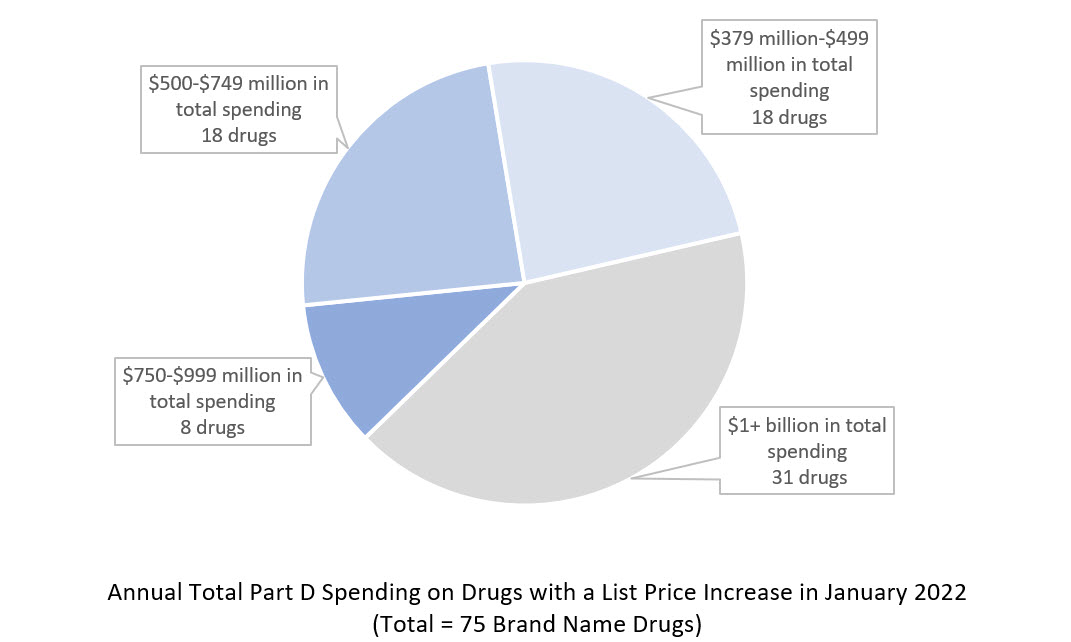AARP Eye Center
Prices for Most Top Medicare Part D Drugs Have Already Increased in 2022
By Leigh Purvis, March 3, 2022 09:59 AM

Brand name drug prices have grown faster than general inflation for over a decade, causing an increasing number of patients to go without necessary medications. Meanwhile, the prices of many other necessities are also rising as the Covid-19 pandemic enters its third year. This confluence of events has been particularly challenging for Medicare beneficiaries, who take an average of four to five prescription drugs every month and have a median annual income of just under $30,000.
Despite the myriad of financial challenges facing patients and all Americans, many brand name drug companies have already increased the prices of their products in 2022.
Three-Quarters of Top Brand Name Drugs Experienced a Price Increase in January
AARP’s Public Policy Institute examined list price changes for the 100 brand name drugs with the highest total Medicare Part D spending in 2020. We found that 75 of these top brand name drugs already increased their list price between the end of December 2021 and the end of January 2022; none of the top brand name drugs experienced a list price decrease.
The average list price increase for the 75 top brand name drugs was 5.2 percent. Price increases ranged from 2.0 percent to 7.9 percent, and more than half of the top brand name drugs with a price increase (42 of 75) experienced an increase of 5.0 percent or more.
More than Half of Top Brand Name Drug Price Increases Were 5 Percent or Higher

Source: AARP Public Policy Institute analysis of Medi-Span Price Rx Pro®.
We also examined Medicare Part D spending on the 75 top brand name drugs that experienced a list price increase in January 2022. Total Medicare Part D spending exceeded $1 billion in 2020 for more than 40 percent (31 of 75) of the top brand name drugs with a price increase in January 2022, and more than three-quarters (57 of 75) of the top brand name drugs were responsible for more than $500 million in annual Part D spending. One top brand name drug with a January 2022 price increase (Eliquis, used to treat atrial fibrillation) was responsible for almost $10 billion in Medicare Part D spending in 2020.
Overall, the 75 brand name drugs with a price increase in January 2022 represented $93.2 billion in total Medicare Part D spending in 2020, nearly half of the $198.7 billion that Medicare Part D spent on all prescription drugs (i.e., brand name and generic drugs) the same year.
Annual Medicare Part D Spending Exceeded $500 Million for More Than Three-Quarters of Top Brand Name Drugs with a Price Increase in 2022

Source: AARP Public Policy Institute analysis of Medi-Span Price Rx Pro®.
Many of the top brand name drugs with a list price increase in January 2022 are widely utilized by Part D enrollees, including Eliquis (used by 2.6 million enrollees), Januvia (used by nearly 1 million enrollees to treat diabetes), and Symbicort (used by more than 1 million enrollees to treat asthma/COPD). Altogether, the 75 top brand name drugs that experienced a list price increase in January 2022 were used by more than 19 million Part D enrollees.
Conclusion
The current analysis reflects a relatively small but important subset of prescription drugs. Similar analyses have identified hundreds of prescription drugs that have already experienced a price increase in January 2022. It is also important to be mindful that price increases have a cumulative impact, as they typically build on price increases in prior years. For example, the average annual cost for using one brand name drug on a regular basis would have been almost $3,700 lower in 2020 ($2,911 v. $6,604) if price changes had not exceeded inflation between 2006 and 2020.
High and growing prescription drug prices will eventually affect all Americans in some way. For example, those with private health insurance will pay higher cost sharing and premiums. Increased government spending driven by drug price increases will lead to higher taxes and/or less spending for other priorities. Equally important, high drug prices and related costs will prompt more older Americans to stop taking necessary medications.
Congress is currently considering legislation that will permit Medicare to negotiate with drug companies, as well as discourage price increases that exceed inflation. If passed, this legislation could help curtail some of the drug industry’s more controversial pricing practices and provide all Americans with much-needed financial relief.























































